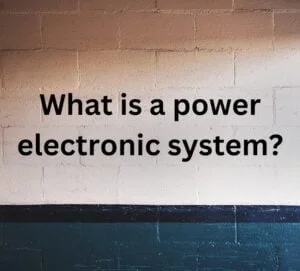Introduction
Power electronic systems, often overlooked in electrical engineering, are vital for controlling everyday devices. They enhance efficiency, reliability, and sustainability, fueling modern technology. This blog covers their basics, applications, advancements, and industry impact.

Understanding Power Electronic Systems
Power electronic systems are devices and circuits that use semiconductor-based switches to regulate electrical power. These switches manage the flow of electrical energy, allowing for the conversion of voltage levels, frequencies, and forms. The versatility of power electronic systems comes from their efficient power management capabilities, which make them suitable for various applications, from household appliances to industrial equipment.
Figure 1 shows a generalized power electronics system block diagram. The power source may be AC or DC. In India, single-phase and three-phase 50 Hz AC supplies are widely available.
Very low power drives usually use single-phase power, while most others use three-phase sources. Low and medium power motors (tens of kilowatts) run on 400 V, with higher power motors rated up to 11 kV or more.In aircraft and space, 400 Hz AC supplies provide a high power-to-weight ratio. Mainline traction systems favor high voltages for cost efficiency, with India using a 25 kV, 50 Hz standard.
Some loads run on batteries, like forklift trucks and milk vans, with voltages typically from 6 V to 110 V DC. Solar-powered drives, used in space and water pumping, run on low-voltage DC. Though costly now, they have strong potential for rural water pumping and low-power transport in the future.
- The power modulator converts the electrical energy from the source to meet the load’s requirements. For example, if the load is a DC motor, the modulator outputs an adjustable direct voltage. If the load is a 3-phase induction motor, the modulator provides adjustable voltage and frequency at its output terminals. When the power modulator performs this function, we call it a converter.
- Selects the mode of operation of the motor, i.e. motoring or braking.
- Modulates flow of power from the source to the motor in such a manner that motor is imparted speed-torque characteristics required by the load.
- During transient operations, such as starting, braking and speed reversal,it restricts source and motor currents within permissible values; excessive current drawn from source may overload it or may cause a voltage dip.
Motors commonly used in power electronic systems are:
- DC motors (shunt, series, compound and permanent magnet)
- Induction motors (squirrel-cage, wound rotor and linear)
- Synchronous motors (wound field and permanent magnet)
- Brushless dc motors
- Stepper motors
- Switched reluctance motors
Power modulators operate under the control of a dedicated control unit. Specifically, the nature of this control unit depends directly on the type of power modulator in use. Additionally, the control unit consistently functions at much lower voltage and power levels. Meanwhile, the sensing unit continuously measures load parameters—such as speed in the case of a rotating machine—and immediately compares them with the input command. Subsequently, the control unit processes the difference between these two parameters and actively governs the turn-on of power semiconductor devices used within the power modulators. Consequently, by adjusting the command input, operators can precisely control the behavior of the load circuit across a wide operational range.
Advantages of power electronic system
1.Energy Efficiency
2.Flexible Control
3.Compact Size
4.High Reliability
5.Fast Response
6.Integration with Digital Systems
7.Reduced Environmental Impact
8.Cost Savings
Conclusion
Power electronic systems play a crucial role in advancing our energy landscape and increasing the use of electronic devices, as technology progresses. Their influence is growing as they shape a future focused on efficient and sustainable energy utilization.

